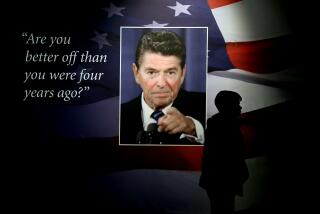THE POLITICS OF CULTURE : Facts? ‘Nixon’ Works on Fears
- Share via
SOUTH ROYALTON, VT. — If Americans have learned anything from the political traumas of the last 30 years--the assassination of John F. Kennedy, the war in Vietnam, the Watergate scandal that brought down President Richard M. Nixon, the Iran-Contra scandal that almost did the same for Ronald Reagan--it is that their government has much to hide. The final words of Oliver Stone’s controversial new film, “Nixon,” tell us the former president spent the last 20 years of his life fighting for control of 4,000 hours of conversations secretly recorded during his years in the White House, and all but 60 hours remain locked up. What secrets are hidden in that vast archive of Nixon’s compulsive talk with the handful of men he trusted about his fears, his enemies, his plans, his past?
Stone’s film proves he has given this question a lot of thought--and he suspects the worst. He has imagined a Nixon whose life is a pyramid of secrets piled layer on layer, each bigger than the last as we work down. Some are political--a suggestion, for example, that Nixon was a prime player in plans by the Central Intelligence Agency to assassinate Fidel Castro during the first year of his rule in Cuba. Under that lies a secret world of American sociology--the power of money wielded by “interests” to pull the strings of U.S. presidential politics. In the deepest layer, Stone finds the wounded child in Nixon’s past, who begged his mother for the love she might give a pet dog. Can we take any of this seriously?
Stone’s previous big film about U.S. political history, a retelling of the Kennedy assassination that was as finely nuanced as a steamroller, won the director a reputation for reckless indifference to facts. This time, he has backed up his film with an annotated screenplay citing a wide range of books and official documents as authority for his version of events. Among them is my book about Richard Helms, the director of the CIA at the time of the Watergate break-in.
Some of Stone’s screenplay hews faithfully to the record--like the scene where White House lawyer John Dean tells Nixon that Watergate is eating away at the moral and political foundations of his presidency with the lethal tenacity of a cancer. Other scenes pass confusingly from the incontestable through a twilight world of the barely possible, on a beeline toward the improbable and the fantastic.
Not surprisingly, the CIA excites Stone’s darkest imaginings. One enduring mystery of Watergate is just what Nixon meant when he told his hard-nosed assistant H.R. (Bob) Haldeman to warn Helms that investigation of the Watergate burglars would blow open “the whole Bay of Pigs thing.”
The reaction of Helms in the screenplay is, as in fact it was, immediate and emphatic. “The Bay of Pigs had nothing to do with this!” he shouted. “I have no concern about the Bay of Pigs!”
The Bay of Pigs, of course, was the site of the failed invasion of Cuba mounted by the CIA in April 1961--only a few months after Kennedy became president. Many of the burglars arrested inside the Democratic National Committee headquarters at the Watergate Hotel in June, 1972, were Cuban exiles who had worked for the CIA. One of the men in charge of the operation was a longtime CIA officer on the covert side of the agency, named E. Howard Hunt--a friend, it turned out, of Helms. But Nixon never explained and Watergate investigators never learned precisely what he had in mind by the Bay of Pigs “thing.”
Stone cut a number of scenes from his film dealing with this episode--depriving us of a chance to see Sam Waterston playing Helms--but they remain in the screenplay, which was recently published. Haldeman’s meeting with Helms has been shifted from the White House to CIA headquarters in Langley, Va., but the words uttered and the emotional tenor of the moment have been faithfully reproduced. It is the rest of the plot line that breaks contact with the mundane world of fact.
Stone’s primary invention is a long encounter between Helms and Nixon at CIA headquarters. Nixon has come with some urgent presidential orders--to find out who’s providing funds for student protest groups; to find out who’s leaking White House secrets to columnist Jack Anderson and the New York Times, and to demand “some old and forgotten papers. Things I signed as vice president. I want the originals in my office and I don’t want copies anywhere else.”
The historical record is clear that Nixon (though his aide John Ehrlichman) did ask for the CIA’s “report” on the Bay of Pigs--as if there were only one, a convenient compendium of all the principal secrets, the size, perhaps, of a paperback romance novel. But everything else about Helms’ half of this exchange is wrong--his sinuous familiarity in calling the president “Dick,” his veiled threats of exposure, demands for increased funding, a faintly sinister stroking of “prize orchids” (a hobby, in fact, of another CIA legend, the counterintelligence panjandrum James Jesus Angleton).
Helms would never have treated Nixon in this overweening, bullying way and Nixon would never have tolerated it. The scene’s dramatic purpose is to introduce a claim that Nixon was involved in the discussions of Castro’s assassination, laying the groundwork for a later suggestion that the famously missing 18 1/2 minutes of taped conversation recorded Nixon’s guilty fear that the men he helped to send after Castro ultimately slipped the CIA’s leash and killed Kennedy.
The factual record includes no such meeting between the two men, and has little to say about Nixon’s role in the plots against Castro. The CIA, far from telling the White House what to do, is in reality more like a kind of sophisticated post office. CIA directors never forget who is the boss.
But what the scene suggests about Nixon’s fears cannot be dismissed out of hand. Nixon certainly knew about the CIA’s plans to raise an army of exiles to overthrow Castro. Approval of the agency’s plan to precede the invasion with Castro’s assassination almost certainly came from “the highest levels” of President Dwight D. Eisenhower’s administration. President Lyndon B. Johnson, among other Washington figures, thought Kennedy’s murder could not be laid at the feet of Lee Harvey Oswald alone. Johnson and others speculated that renegade Cubans might have played a role. Everyone involved in the plotting against Castro has lied about it to varying degrees. Historians quarrel about who knew what, planned what, did what. A man as secretive as the Nixon of record might well have harbored fears as dark as Stone’s imagining.
Stone’s previous film, “JFK,” was full of outright fabrication--invented characters, scenes and conversations more or less claiming that Kennedy was murdered by a consortium of forces representing the CIA, the Pentagon and the military-industrial complex, to stop him from pulling the United States out of Vietnam.
This was not merely wrong but deeply pernicious, inciting a level of suspicion of government that no democracy could tolerate for long. With a straight face, Stone insisted he was in earnest, citing books and documents to support his claims. No serious student of the assassination paid any attention. The film stood or fell on whether it was true--and the consensus was that “JFK” was as false as a three-dollar bill.
“Nixon” is something else. This time, books and documents for the most part support Stone’s version of events, even when he indulges in pure invention--as in one scene where J. Edgar Hoover, played by Bob Hoskins, steers candidate Nixon away from a Mafia kingpin involved in the plot to kill Castro. The meeting never occurred; the details are all askew. But the essence is right: Hoover was a sybarite, he blackmailed presidents, he knew of and exploited the CIA’s attempt to use the Mafia against Castro, he ran the FBI like a private fiefdom.
You can’t call it history but Stone’s film, for all its liberties with prosaic truth, bears more than a passing resemblance to the underside of government as it has been exposed in one investigation after another since Kennedy’s murder first raised suspicion that something dark and violent could be roiling beneath the surface of American life.
The traumas of the last 30 years have left a legacy of suspicion in the popular mind, a sense that much of what matters most in government is hidden. The Eisenhower years, in retrospect, seem a lost era of innocence. “Nixon” is a kind of Wagnerian epic, full of storm and strife, drawing a dark, powerful portrait of what Americans fear their country has become.
It is effective drama. But it is not the real world.
More to Read
Only good movies
Get the Indie Focus newsletter, Mark Olsen's weekly guide to the world of cinema.
You may occasionally receive promotional content from the Los Angeles Times.










